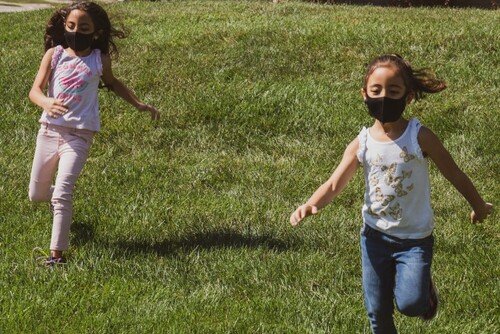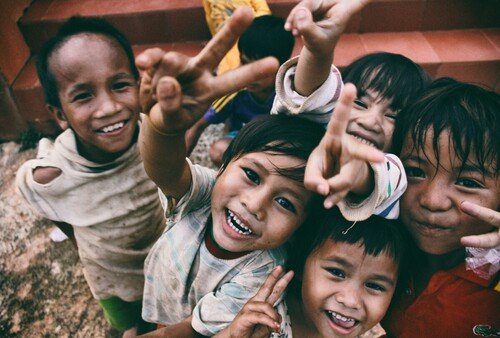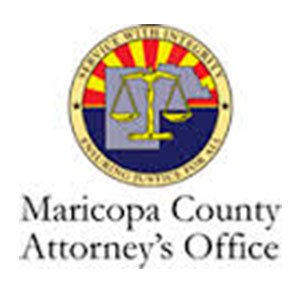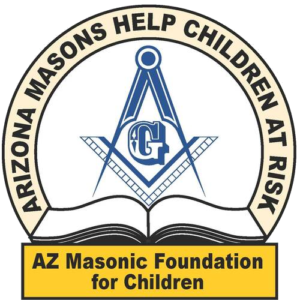

We pray for children…
…who put chocolate fingers everywhere,
…who like to be tickled,
…who stomp in puddles and ruin their new pants,
…who sneak Popsicles before supper,
…who erase holes in math workbooks,
…who can never find their shoes.
And we pray for those…
…who stare at photographers from behind barbed wire,
…who can’t bound down the street in new sneakers,
…who never “counted potatoes,”
…who are born in places we wouldn’t be caught dead in,
…who never go to the circus,
…who live in an X-rated world.
We pray for children…
…who bring us sticky kisses and fistfuls of dandelions,
…who sleep with the cat and bury goldfish,
…who hug us in a hurry and forget their lunch money,
…who squeeze toothpaste all over the sink,
…who slurp their soup.

And we pray for those…
…who never get dessert,
…who have no safe blanket to drag behind them,
…who can’t find any bread to steal,
…who don’t have any rooms to clean up,
…whose pictures aren’t on anybody’s dresser,
…whose monsters are real.
We pray for children…
…who spend all their allowance before Tuesday,
…who throw tantrums in the grocery store and pick at their food,
…who like ghost stories,
…who shove dirty clothes under the bed,
…who get visits from the tooth fairy,
…who don’t like to be kissed in front of the car pool,
…who squirm in church and scream on the phone,
…whose tears we sometimes laugh at and whose smiles can make us cry.
And we pray for those…
…whose nightmares come in the daytime,
…who will eat anything,
…who have never seen a dentist,
…who are never spoiled by anyone,
…who go to bed hungry and cry themselves to sleep,
…who live and move, but have no being.

We pray for children…
…who want to be carried
…and for those who must,
…for those we never give up on
…and for those who never get a second chance,
…for those we smother.
…and for those who will grab the hand of anybody kind
enough to offer it.
We pray for children. Amen.
– “Prayer of Responsibility,” Ina Hughes (Prayer of Responsibility for Children ©1995 William Morrow publishers)

What we CAN do, is to support programs like the Masonic Student Assistance Program (MSAP). MSAP is a three-day workshop that gives educators the tools to accomplish the following:
* identify children at risk by evaluating the developmental assets available to the child;
* create the child’s school-based individualized plan of action;
* implement the plan;
* follow up on the impact’s effectiveness;
* post-care, to help ensure the child’s progress is sustainable.
Participants leave the training with several, significant tools. Based on a selected case study child, their team designs a specific plan for behavioral interventions. They also create a system for implementing MSAP in their current school program. They learn to incorporate worthwhile MSAP concepts and practices, such as how to gather data, complete necessary paperwork, and develop a school-based action plan for the study child.
Child Poverty
1,683 babies are born into poverty.
Child Welfare
Youth Justice
Gun Violence & Fatalities
Child Poverty
Child Welfare
Youth Justice
Gun Violence
The impact of supporting MSAP in your community school is significant, with trained core teams being able to help prevent and promote the following:
Abilities to identify, address, and mitigate the following issues, before they become reality:
* suicide;
*alcohol and drug abuse;
*depression;
*bullying;
*poor attendance and school drop outs;
*continuation of endemic poverty;
*non-violent crime; and
*violent crime, including mass murder that has become nationally prevalent.
As well as the attendant benefits of: increased life skills and developmental assets for k-12; and increase effectiveness and efficiency of the core team in the areas of enabling and codependence; comprehensive planning, team work; and group dynamics.
National Statistics Tell Us That Every Trained Educator Will Positively Impact 5 -9 At-Risk Children in Their Very First Year After The Class.
MULTIPLIER CONTINUES YEAR OVER YEAR!














In the US, one in five children, or 656,000, were maltreated in 2018, according to the U.S. Department of Health & Human Services (HHS).
If you are an educator, we encourage you to:
For educators and non-educators (the rest of us) alike, we would love for you to:
For Truly, a Child at Risk Will Remain At-Risk Until Someone Intervenes – Join US, and Intervene Today!

